4 Lakes and a River: The World’s Most Polluted Bodies of Water
“If we pollute the air, water, and soil that keep us alive and well and destroy the biodiversity that allows natural systems to function, no money will save us.”
– David Suzuki
Water pollution threatens biodiversity across the globe. There is no question that degraded water sources are becoming increasingly worse. Pesticides, agricultural run-off, industrial chemical sources, and untreated sewage are some pollutants that plague water sources.
Water pollution is a severe problem that humans need to acknowledge if we want to preserve the Earth.
This blog is special because it was brought to our attention by a group of middle school students researching environmental pollutants. Disappointed by their findings, they asked AMD Environmental Consultants to share and highlight some of the world’s deadliest bodies of water on our blog.
The young researchers identified five concerning bodies of water with the hope of raising awareness worldwide.
Lake Erie Dead Zone
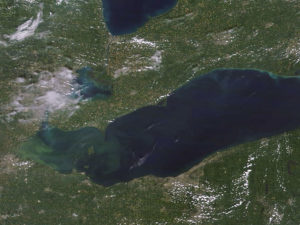 Lake Erie is the largest of five Great Lakes in North America, reaching Michigan, Ohio, Pennsylvania, and New York. The lake gets its name after the Native American Eriechronon people.
Lake Erie is the largest of five Great Lakes in North America, reaching Michigan, Ohio, Pennsylvania, and New York. The lake gets its name after the Native American Eriechronon people.
Every summer, a hypoxic zone develops at the bottom of the central basin of Lake Erie. Massive algal blooms feed off of agricultural and urban run-off. Nitrogen and phosphorus from fertilizers and waste stimulate algae growth, turning part of the lake into a “dead zone.”
Fertilizer helps crops grow and provides nutrients to nearby soil. Consequently, the same nutrients feed the growth of algae, bacteria, and tiny organisms.
Dead algae settle at the bottom of the lake, where bacteria decompose. Low oxygen zones affect the quality of fish habitats, including the water’s temperature. Oxygen-deprived fish in Lake Erie leave the deep, cooler water that they inhabit to occupy other areas with more oxygen.
Disruption of ecosystems may interfere with survival rates because of warmer temperatures and impact predator/prey relationships.
Lake Onondaga
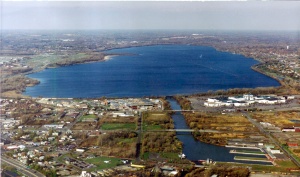 Just outside of Syracuse, Central New York is home to Lake Onondaga. The lake covers about 4.6 square miles and has an average depth of 35 feet. Lake Onondaga was once a tourist attraction because of its beautiful beach area and nearby amusement park in the 19th century. Industrial pollution would ultimately plague this freshwater for over 100 years. Once local manufacturing boomed in the late 1880s, the nearby water quickly became contaminated.
Just outside of Syracuse, Central New York is home to Lake Onondaga. The lake covers about 4.6 square miles and has an average depth of 35 feet. Lake Onondaga was once a tourist attraction because of its beautiful beach area and nearby amusement park in the 19th century. Industrial pollution would ultimately plague this freshwater for over 100 years. Once local manufacturing boomed in the late 1880s, the nearby water quickly became contaminated.
Mercury, salt processing residue, and other waste contaminants increased the toxicity in the fish and aquatic life and decreased the wildlife population that once inhabited the surrounding area.
Mercury is particularly toxic to living organisms because of its neurotoxic effects. It poisons fish, wildlife, and the humans who consume it through food sources.
Lake Onondaga was a thriving body of water, home to many aquatic organisms, and considered safe to swim in. Still, polluted run-off and industrial waste led to a ban on swimming in 1940 and fishing in 1970.
Indeed one would think that was enough for one community to sustain, yet the pollution kept coming. After ammonia and phosphorus entered the water, sewer overflow negatively impacted fish migration and reproduction. This waste is significant because it causes algae to grow faster than an ecosystem can handle. Not only does algae cause harm to the water quality, but it also decreases the levels of oxygen in the water, similar to the effects seen in parts of Lake Erie.
How did Onondaga County handle the cleanup of Lake Onondaga? Onondaga County was designated a superfund site in 1994. The cleanup required Onondaga County to comply with the Clean Water Act. The wastewater and treatment plants acted according to remediation guidelines. All government municipalities cooperated with cleanup efforts.
Lake Karachay
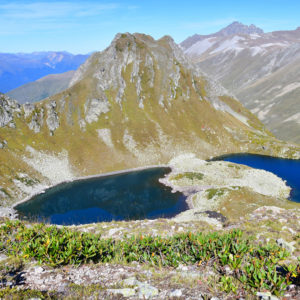 Lake Karachay is arguably the most polluted place on Earth. Once a dumping ground for nuclear waste, it is not safe for humans to stand near the shore. Radioactive exposure is so significant that a human will surely die after one hour near the lake.
Lake Karachay is arguably the most polluted place on Earth. Once a dumping ground for nuclear waste, it is not safe for humans to stand near the shore. Radioactive exposure is so significant that a human will surely die after one hour near the lake.
The nearby nuclear facility in Chelyabinsk Oblast, Russia, is responsible for dumping the radioactive waste into the lake. Between 1951 and 1953, the open-cycle reactors of the Mayak Plutonium Plant disgorged high-level radioactive waste directly into the lake, and medium-level waste continued to be dumped there until the 1990s. The radioactivity is also in the sludge that lines the lake bed.
A drought in the 1960s, combined with high winds, caused radioactive dust to irradiate over half a million residents near the nuclear-active lake. Cancer rates increased dramatically as a result of living near Lake Karachay.
Ten thousand hollow concrete blocks were added to the lake from 1978 to 1986 to keep the sediment from shifting.
To this day, Lake Karachay is one of the most polluted areas globally, even earning the title, Most Radioactive Lake according to the Guinness World Records.
Lake Natron
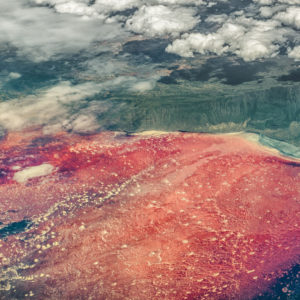 Lake Natron is not necessarily poisonous due to human activity; it’s still one of the world’s deadliest bodies of water. Lake Natron remains impacted by volcanic activity.
Lake Natron is not necessarily poisonous due to human activity; it’s still one of the world’s deadliest bodies of water. Lake Natron remains impacted by volcanic activity.
At first glance, you are in awe of Lake Natron’s beauty. The picturesque still of the lake draws living creatures into its waters, only to be entombed in stone or what appears to be stone.
Located in Northern Tanzania, northwest of the city of Arusha, Lake Natron is highly poisonous because the waters feed through the material of a nearby volcano, Mt Ol Doinyo Lengai. The water, saturated with salt, soda, and magnesite deposits, creates the perfect environment for bacteria to grow – the kind of bacteria that harms the insides of those that drink the water. Birds and other animals wind up dead due to drinking the bacteria-ridden water.
But something else happens to birds, animals, and bats who enter the water. They appear to turn to stone when in actuality, they are calcified. The water contains sodium carbonate, a white alkaline compound. The calcification of animals is a peculiar event that has the attention of scientists and photographers worldwide.
 Nick Brandt, a talented photographer, carefully extracted the animals from the lake and photographed them in lifelike poses. He discovered, that when the water recedes, the birds’ desiccated, chemically-preserved carcasses wash up along the coastline.
Nick Brandt, a talented photographer, carefully extracted the animals from the lake and photographed them in lifelike poses. He discovered, that when the water recedes, the birds’ desiccated, chemically-preserved carcasses wash up along the coastline.
Smithsonian Magazine recounts Brandt’s recollection of his time spent in Northern Tanzania. Brandt worked with locals to collect some of the most finely-preserved specimens. “They thought I was absolutely insane—some crazy white guy, coming along offering money for people to basically go on a treasure hunt around the lake for dead birds,” he says. “When, one time, someone showed up with an entire, well-preserved fish eagle, it was extraordinary.”
Citarum River
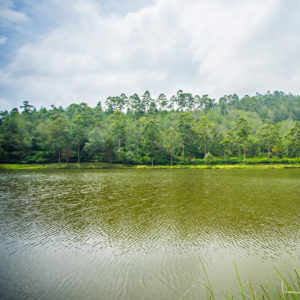 Like many countries, Indonesia relies on water sources for economic growth and environmental sustainability. One river, in particular, is necessary for 25 million people who depend on it for agriculture, water, and electricity. Unfortunately, 25 million people rely on a heavily polluted river with garbage covering the surface. Fishers regard themselves as garbage collectors because most fish population has died or migrated to other areas. The water’s surface resembles the inside of a trash can – bottles, household debris, waste, and even dead animals.
Like many countries, Indonesia relies on water sources for economic growth and environmental sustainability. One river, in particular, is necessary for 25 million people who depend on it for agriculture, water, and electricity. Unfortunately, 25 million people rely on a heavily polluted river with garbage covering the surface. Fishers regard themselves as garbage collectors because most fish population has died or migrated to other areas. The water’s surface resembles the inside of a trash can – bottles, household debris, waste, and even dead animals.
Waste-producing factories line the river’s basin while another human activity continues to destroy what should be a viable water source. Fecal matter and lead contaminate the Citarum River, exceeding acceptable limits.
The environmental impact on this river is significant, with numerous sources of contamination infiltrating the water. Fecal matter is amongst the pollutants in the river, indicating the presence of sewage contamination from the fecal material of humans or other animals.
Other issues with the water include disease-producing bacteria or viruses, virtually plaguing the millions of nearby water-dependent residents.
The Indonesian government committed to revitalizing the river by 2025. It’s a lofty goal but one that is supported by International Monetary Fund and the Asian Development Bank.
Is there a solution to the world’s water pollution problems?
The solution to the world’s water pollution problems may not be easy, but certainly not out of reach.
If the future generation can wrap their minds around these problems, then we should expect the same from people who are in a position to influence the decisions made.
Real change starts with informed decisions based on accurate data.
AMD Environmental Consultants devotes time and resources to testing drinking water for lead and other hazardous waste pollutants. The belief that communities deserve clean water fuels our efforts every single day.
The Purpose Behind the Blog Post
As a company, we never want to become complacent, and we certainly do not want to stop listening to young minds who only have the Earth’s best interest at heart.
The four middle school students who inspired this blog post shared their thoughts about clean water and pollution. I think we can learn a thing or two from these young researchers.
The curious 5th-grade learners attend Transit Middle School in Williamsville, New York. They have this to say about the importance of clean drinking water and what can be done to prevent pollution:
Ella
“Clean water matters because people and animals need safe, drinkable water free from toxins. My future kids deserve safe water; marine life should be free from toxic chemicals. One way to keep water from becoming polluted is to keep textile factories away from water sources.”
Nora
“We use water for everything. Do you want dirty water to use? The Earth gives us so much, and we (humans) give back dirty water. We have done this to ourselves. Some people only have dirty water to wash clothes, drink, water plants, and swim. The water is dirty because rivers and water sources worldwide are polluted. People and wildlife get sick from polluted water. There are things people can do to clean up water sources. Fundraising is one way for people to help.”
Mili
“Water is the basic utility of life. You need it to digest your food, which helps keep you hydrated. Water also helps to get rid of waste. Clean water matters because, without clean water, living organisms won’t be able to function properly. They will become sick and will soon die. Anyone can help to avoid water pollution. People can contribute to activities that help to keep the Earth clean. One of the most basic ways to avoid water pollution is to pick up litter. We should also limit paper usage by printing information on both sides of a piece of paper. People can recycle items instead of throwing them all into the trash can.”
Sri
“Clean water matters because we drink, take baths, and wash our food with it! We use it daily! People should avoid water pollution because it affects our health, bodies, and future generations!”
AMD Environmental is listening. We fully agree that more must be done to protect and preserve “the basic utility of life.” Our team will continue to test local water sources using advanced technology and best practices.

